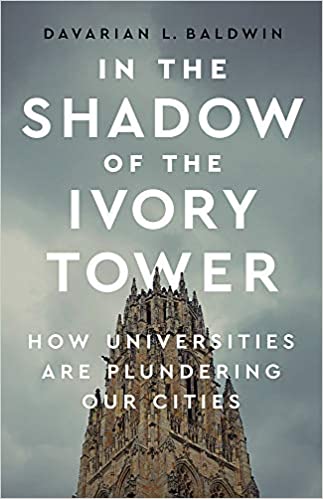You have /5 articles left.
Sign up for a free account or log in.
 In the Shadow of the Ivory Tower: How Universities Are Plundering Our Cities by Davarian L. Baldwin
In the Shadow of the Ivory Tower: How Universities Are Plundering Our Cities by Davarian L. Baldwin
Published in March 2021
The book I’ve been talking up to my higher ed network lately is Davarian L. Baldwin’s In the Shadow of the Ivory Tower. Baldwin, an American studies professor at Trinity College, has written a devastating critique of the urban university.
Contrary to the conventional wisdom that universities are universally local net positives, Baldwin builds a case that institutions of higher learning all too often damage as much as improve the communities in which they are embedded.
Baldwin’s argument on the problematic relationship between residents and urban universities is grounded in several case studies. The book contains in-depth chapters on Trinity (Hartford, Conn.), Yale (New Haven, Conn.), U of Chicago (Chicago’s South Side), NYU and Columbia (NYC), and ASU (downtown Phoenix campus). Students of higher education will learn much about the institutional history, growth and challenges of these universities in all of these chapters.
Among the urban town-gown themes that Baldwin explores, three stand out. The first is the history of the urban universities profiled to attempt to wall themselves off from the low-income and largely nonwhite populations of the urban cores in which they reside (or have expanded into).
While acknowledging that the recent trend among university leaders has been to embrace urban community-campus connections, Baldwin concludes that rhetoric and actions seldom line up. In his estimation, wealthy city schools continue to construct physical and cultural barriers between themselves and the communities in which they are situated.
A second theme Baldwin identifies as common across wealthy universities in racially and economically diverse cities is the ever-present danger of gentrification. Universities seldom prioritize funding or building low-income housing for nonstudents, nonfaculty or nonstaff (everyone else) in their capital budgets.
As urban universities expand into their cities, local rents inevitably go up, and the supply of affordable housing diminishes. Family-run businesses, some of which had been present for decades, can no longer afford the rising rents. Minority-owned stores and restaurants get replaced by corporate chain providers.
The growth of university policing into university adjacent neighborhoods is a third theme explored in In the Shadow of the Ivory Tower. In efforts to combat fears of crime among students, parents and university employees, a handful of urban schools have gained expanded policing powers. University police are gaining arrest powers not only on the traditional campus core but on blocks on which students live or where universities have expanded their office space.
While expanded patrols are welcome by some neighborhoods, there is also the perception that campus police can be heavy-handed and tone-deaf when interacting with community members.
In the Shadow of the Ivory Tower is a book that I very much want to discuss with my friends in higher ed. This is one of those books that mostly goes against what I thought I understood and believed about the role of universities in society.
If you had asked me about the impact of urban universities on their cities prior to reading In the Shadow of the Ivory Tower, I would have given an upbeat assessment. I would have told you that universities bring vibrancy, jobs and culture to the places in which they reside.
Sure, I would have perhaps mentioned concerns about the potential negative impact of nonprofit schools being exempt from property and other taxes on local revenues and services. But I would have argued that the loss of some tax dollars is almost always entirely outweighed by the local benefits that universities bring.
Now I’m not so sure. Not that I’m fully persuaded by In the Shadow of the Ivory Tower. I think the book would have been stronger if it had more fully explored the positives, as well as negatives, of urban universities.
Still, this book has me questioning some of my core assumptions.
I want to learn more.
What are you reading?




